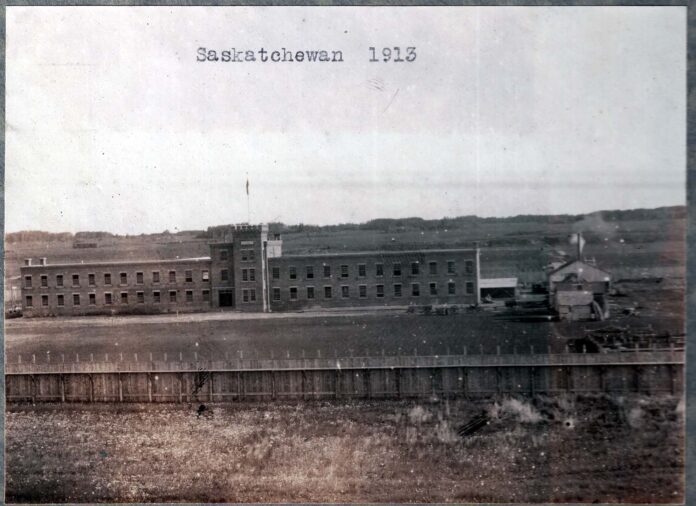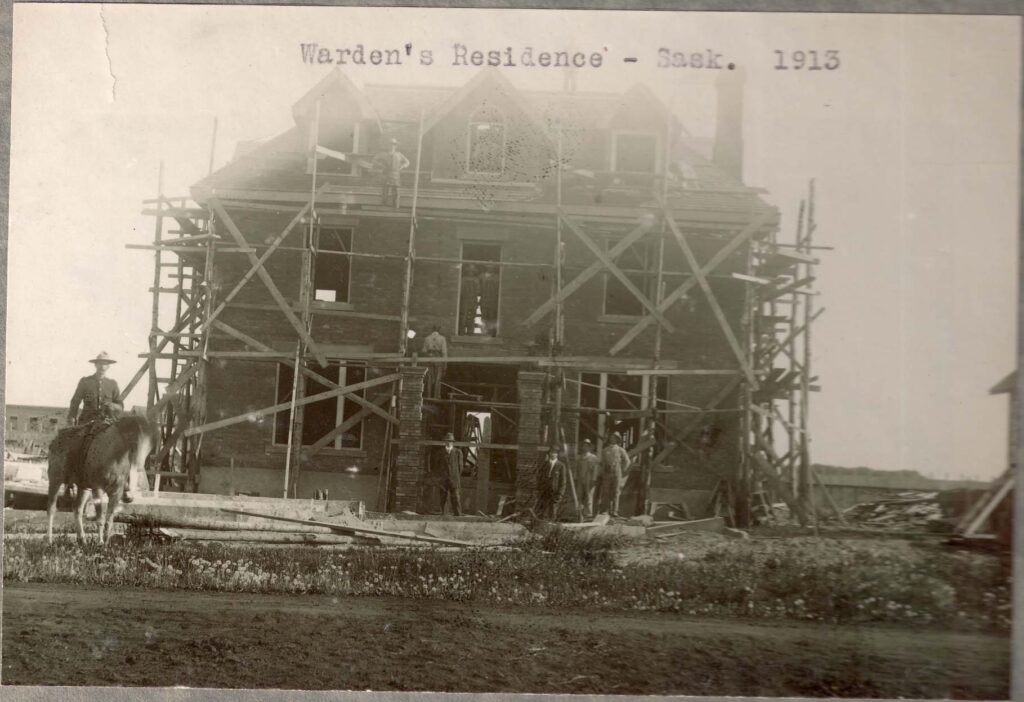
by Fred Payton
Prince Albert Historical Society
Over the summer, I was researching the history of Prince Albert’s river lots. I chanced on an article which mentioned the sale of one such property to the federal government as part of its land acquisition on which to build the Saskatchewan Penitentiary. Here, I thought, was a lead which might help me to determine what prompted the decision to build the federal prison in Prince Albert, as well as providing me with further evidence to disprove that long held misconception that Prince Albert had chosen the penitentiary over the university.
As there is considerable documentation available about the selection of the site for the university, I chose to begin there.
The British North America Act granted the provinces power over education, so upon the creation of Saskatchewan in 1905 it was up to the new government in Regina to determine the location of the provincial university. Regina, as the capitol, Saskatoon, Indian Head, Moose Jaw, and several other communities all indicated interest, as did Prince Albert.
This city’s claim to its right as the university city stemmed primarily from the existence of a federal charter, passed by the Dominion Parliament in 1883, establishing the University of Saskatchewan at Prince Albert. Emmanuel College had immediately become a part of the federally chartered university. However, as a result of the powers granted by the BNA Act, the provincial government would not admit Prince Albert’s claims wich were based on a Dominion charter.
It was not until 1907 that the University Act came into effect in the province. It empowered the university’s Board of Governors to determine the institution’s location, with the expectation that its decision would be ratified by the provincial government.
After the decision was made that the College of Agriculture would be a part of, rather than separate, from the university, Indian Head removed itself from consideration. That community was only interested in having the Agriculture college.
Late in the evening of April 07, 1909, the Board of Governors were to make their decision. The Board consisted of nine members – four from northern Saskatchewan, four from the south, and the President of the University, Walter Murray.
It was determined that the vote would be by ballot, with the community receiving the fewest number of votes being removed from the list after each ballot. Fort Qu’Appelle, Lloydminster, and North Battleford were given consideration, but did not receive sufficient support.
Prince Albert’s board members made strong representation for the university to be established in our city.
However, when it came down to the final ballot, the two remaining locations were Regina and Saskatoon. If Prince Albert had a choice, it was a choice between a nearer and a further destination.
The President and the governors from Regina and Moose Jaw voted for the southern city. The governors from Saskatoon, Prince Albert, as well as those from Wolseley and Maple Creek all voted for Saskatoon.
The decision with respect to the location of the university, as you will see, was made in April 1909. Yet the federal land acquisition for construction of the federal penitentiary was reported to have been made in 1906.
Further research was obviously worth pursuing.

The first public indication that Prince Albert was to be home to the penitentiary can be found in the Saturday, September 8th, 1906 edition of the Winnipeg Tribune. That newspaper reported that “Prince Albert is going to have the Saskatchewan penitentiary. Options are being secured on land a mile west of the city. About 1,200 acres is wanted and options have been secured on 790 acres. What the land was wanted for has leaked out and the property in the vicinity has gone up in price.”
I have been able to obtain three documents from 1907 and two from 1908 which I believe are of interest.
A copy of an order in council from March 1907 signed by W.E. Gladstone approved the purchase of 183.5 acres of land from an individual named R.S. Cook, the land in question being required in connection with the proposed establishment of a penitentiary for the province. This land included the fractional south east quarter of Section 7 in Township 48, Range 26 west of the 2nd meridian (about 75 acres), as well as all that part of River Lot 57 of Prince Albert settlement lying east and southeast of the Regina, Long Lake and Saskatchewan Railway (about 42 acres) and the west southerly 66.5 acres of River Lot 58, Prince Albert settlement. The purchase price of $30.00 per acre was considered fair and reasonable, and Mr. Cook received $5,500.00. It is unknown at what price he had purchased this land.
However, R.S. Cook subsequently filed a “Quit Claim” deed in favour of His Majesty King Edward VII of all his interest in the property on River Lot 58. Further documentation suggests that Mr. Cook was, at the time he purchased the property, an employee of the federal Department of the Interior, a position which debarred him from purchasing Dominion lands under Section 14 of the Revised Statutes of Canada. It would seem that, with inside knowledge, he had made the purchase in the expectation that he would be able to make a good profit when he came to sell the land to the government. The order-in-council rescinding the sale of the land was signed by no less than Wilfrid Laurier.
It would appear that the Department of the Interior and Mr. Cook had come to an agreement which allowed him to keep a portion of the land he had bought, even though at the time debarred from such purchase, provided he give up to the Crown land which was of most importance for the construction of the federal institution.
An order-in-council, also signed by Laurier but in 1908, approved the sale of land from Mrs. J. Eliza Drever for that piece of land situated on the south side of the Carlton, Saskatchewan, Forks Trail, being that portion of River Lot 57 and containing one acre, which was land to be located within the penitentiary reserve at Prince Albert. The Minister indicated that it would be most objectionable to have a plot in the heart of the reserve and in the immediate vicinity of the prison buildings which would be owned and occupied by persons not in any way connected with the penitentiary. Mrs. Drever received $1,000, which was deemed by the “Inspectors of Penitentiaries and the clerk of works of the Department in Regina to be a fair and reasonable price”.
The second order-in-council signed by Wilfrid Laurier in 1908 approved the of purchase of land owned by the Anglican Diocese of Saskatchewan. Lots 55 and 56 were necessary to complete the site for the proposed penitentiary. The Diocese had offered to sell them, less about ten acres which were reserved for the church yard, at the rate of $55.00 per acres. They also agreed to sell buildings on the land for $5,000.00. These buildings included those structures which were no longer in use as residences for the bishop, clergy and others, including the residential school which had been closed in June of that year when the federal government failed to agree to provide the appropriate monies necessary to allow the level of education which the church wanted for their indigenous students. One of these buildings still survives today, after being moved in the mid-1920s to the 700 block of 15th Street West.
These documents make it clear that the decision to establish the penitentiary in Prince Albert preceded the decision to place the provincial university in Saskatoon, and that Prince Albert did not choose the penitentiary over the university. But no documentation has been found to indicate why the federal government chose to build the prison here.
It is possible that the decision resulted from the previous existence of the territorial gaol in Prince Albert from the 1880s until it became a provincial facility in 1905. But that is simply speculation on my part.
One other newspaper report which has come my way might suggest why people have been willing to accept the story that Prince Albert chose the penitentiary over the university. The April 26, 1909 edition of the Saskatoon Daily Phoenix carried a story from the Calgary News. It read that “The Dominion penitentiary for Saskatchewan is to be built at Prince Albert. We know that Senator Tom Davis would see to it that some educative institution would be located there, even if the university had to go to Saskatoon.”

